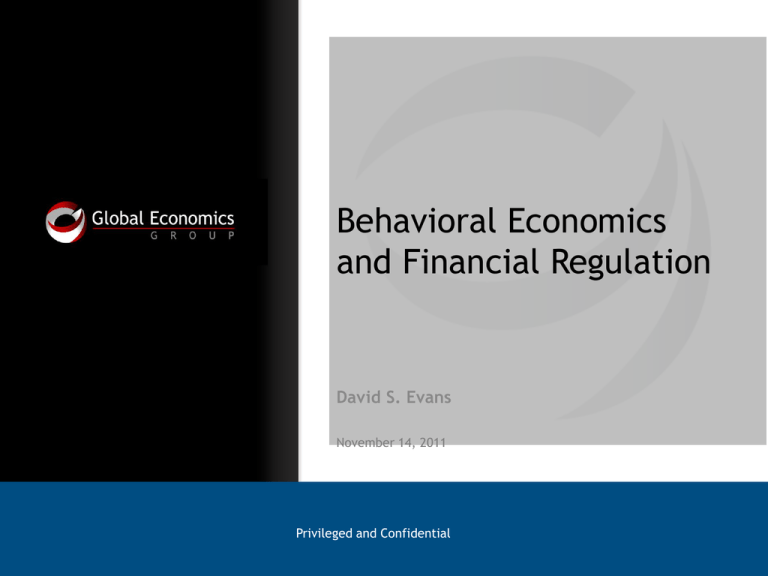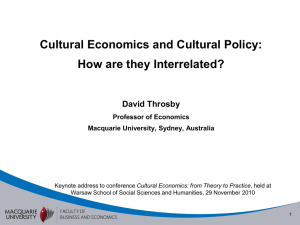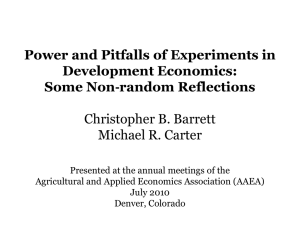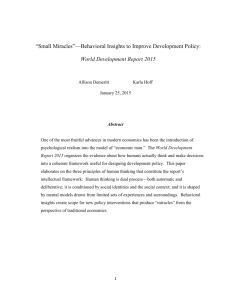Behavioral Economics Presentation
advertisement

Behavioral Economics and Financial Regulation David S. Evans November 14, 2011 Privileged and Confidential BEHAVIORAL ECONOMICS (AND WHY YOU SHOULD CARE) November 14, 2011 Behavioral Economics Combines Economics and Psychology How do people actually behave? Why do they behave that way? What are the implications for markets? November 14, 2011 Behavioral Law and Economics Applies BE to Regulation Consumers make mistakes Businesses take advantage of consumer mistakes Government can help consumers by preventing consumers from making mistakes or businesses from relying on these mistakes November 14, 2011 Behavioral Economics Has Come to Town Cass Sunstein Sendhil Mullainathan Director, OIRA, White House’ “Chief Economist” CFPB Founder of Behavioral Law and Economics Leading behavioral economist Co-author of “Nudge” November 14, 2011 Co-author of leading paper on BE regulatory intervention in financial markets Why Should You Care? Provides regulators new set of tools Lawyers will be dealing with behavioral economics at regulatory agencies Businesses will need to consider behavioral economics based regulations November 14, 2011 KEY FINDINGS OF BEHAVIORAL ECONOMICS November 14, 2011 After Several Million Years You’d Think We’d Be Smart November 14, 2011 But Behavioral Economics Finds People Aren’t So Smart… • People are influenced by baselines (inertia) • People have limited attention and make mistakes as a result of simplifying complex problems. • People aren’t very good at math • People are overconfident in ability to stick to plans such as saving • People are overly optimistic about themselves and their futures “Cross-cutting Biases” “Expectation Biases” • People have trouble doing present value calculations • How choices are framed heavily influences decisions • The presence of other options can bias choices • People reject all choices if there are too many • People “live for today” expecting to be more patient tomorrow but then tomorrow is today • People place more value of items in their possession than the same item not in their possession “Price and Valuation Biases” November 14, 2011 “Preference Biases” Cross-Cutting Biases People are influenced by baselines and are subject to inertia People have limited attention and make mistakes as a result of simplifying complex problems. People aren’t very good at math November 14, 2011 Expectation Biases People are overconfident in ability to stick to plans such as saving People are overly optimistic about themselves and their futures November 14, 2011 Price and Valuation Biases People have trouble doing present value calculations How choices are framed heavily influences decisions The presence of other options can bias choices People reject all choices if there are too many November 14, 2011 Preference Biases People “live for today” expecting to be more patient tomorrow but then tomorrow is today People place more value of items in their possession than the same item not in their possession November 14, 2011 Perhaps Its All Been Said Before • An 1884 editorial in Scientific American discussed “the curious processes of reasoning” that women used in deciding to buy a sewing machine on an installment plan. The author discovered the “psychological fact, possibly new,” that women “will rather pay $50 for a machine in monthly installments of five dollars rather than $25 outright, although able to do so.” November 14, 2011 BEHAVIORAL ECONOMICS BASED REGULATION November 14, 2011 Helping People Help Themselves Make sure people have the right information for basing decisions Make people get that information in a way that reduces their costs of making right decisions Make sure information is presented in a way that requires the least math etc. skills November 14, 2011 Soft Paternalism Figure out what the “right” decision is--the one a “rational well-informed” person would make) Nudge people towards making the decision “WE” think is right November 14, 2011 Hard Paternalism Figure out what the “right” decision is-the one a rational well-informed person would make Prevent businesses from offering options that would result in consumers making the “wrong” decision Preventing consumers from making “wrong” choices November 14, 2011 Reasons to be Skeptical of BEBased Regulation Existence and degree of biases still controversial Market importance of cognitive failures disputed Regulatory cures may be worse than disease Regulators are imperfect humans too November 14, 2011 Not so Easy Problems Perhaps 400% Payday loans Advertisements for gold coins Nudges to invest in 401-k plans November 14, 2011 CFPB AND APPLICATION TO FINANCIAL MARKETS November 14, 2011 Behavioral Foundations of CFPB Regulation November 14, 2011 People have “systematic cognitive failures” Market incentives drive business to offer products designed to “exploit” these failures Regulatory response favors products that minimize consumer “mistakes” from those failures Experiments, surveys, and statistical analysis can help guide “evidencebased regulatory” analysis Sample “Problems” in Financial Services Consumers make impulsive borrowing decisions Consumers overly optimistic about paying things off Consumers borrow too much and pay too much because they underestimate cost of financing Financial institutions frame choices, add complexity and provide defaults to encourage people to make “bad” decisions Competition among financial institutions can’t fix these problems November 14, 2011 Preemptive Design Principles Transparency: Make It Clear Simplicity: Keep It Simple Helpfulness: Help People Help Themselves November 14, 2011 Honesty: No Tricks and Traps Research: Test for the Best CONCLUSION November 14, 2011 Concluding observations Behavioral economics is probably here to stay Can provide useful tools to regulators and business people Should come with all the “buyer beware” warnings as any part of economics Opens door for very paternalistic regulation which raises both economic, legal and political issues November 14, 2011 THANK YOU! devans@globaleconomicsgroup.com www.globaleconomicsgroup.com/ November 14, 2011








